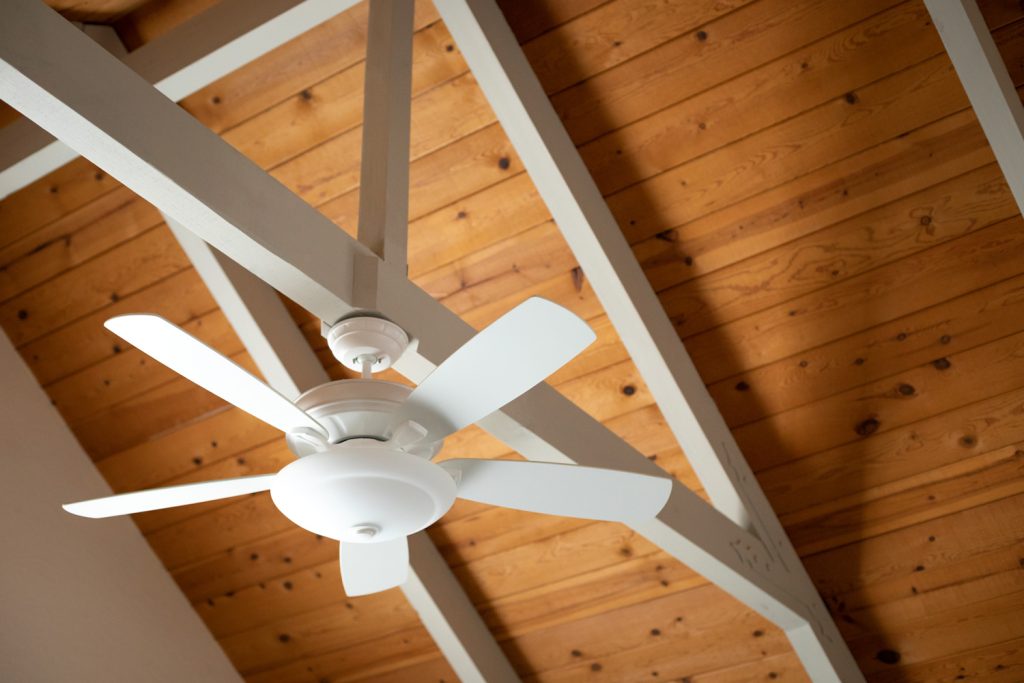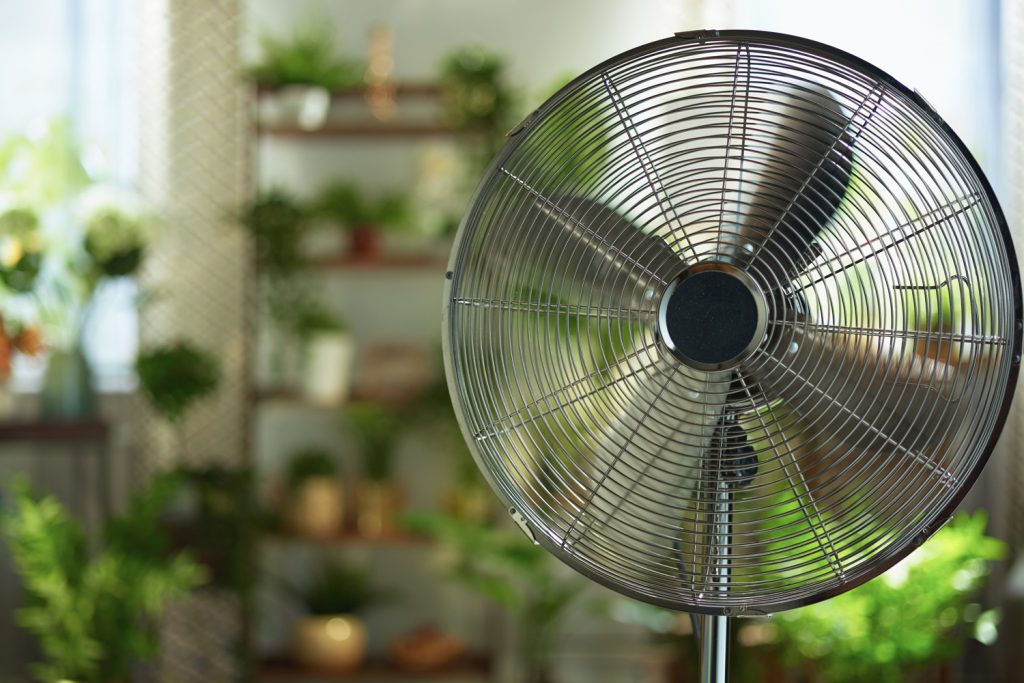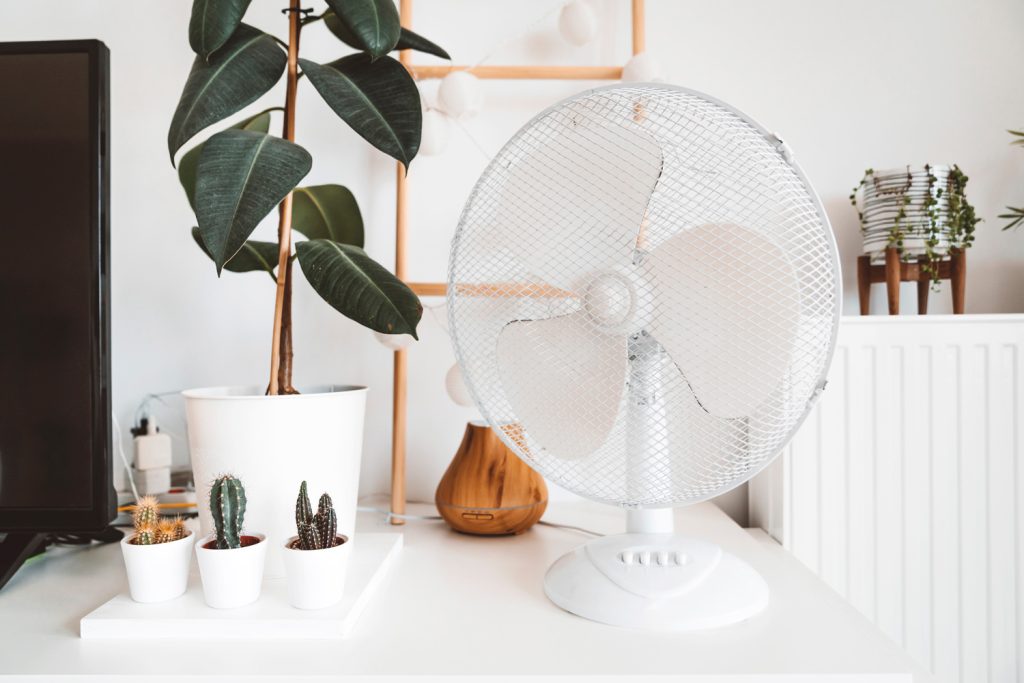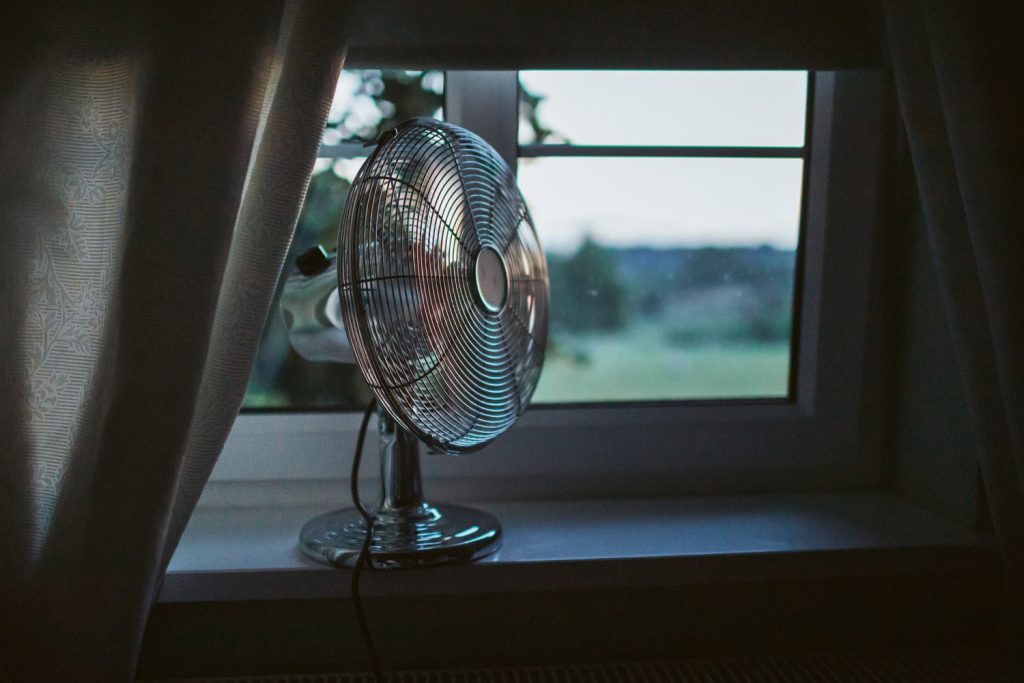It comes as no surprise that one of the most used appliances is the humble fan. Most of us use it for hours on end during the summer days. You may be wondering, how much wattage does a fan use per hour or per day? Continue reading because we’ve researched everything and found answers for you.
The average wattages of different kinds of fans per hour and day are:
- Ceiling Fan: 0.055 to 0.09 kWh (1h) and 1.32 to 2.16 kWh (24h)
- Whole-House Fans: 0.12 to 0.6 kWh (1h) and 2.88 to 14.4 kWh (24h)
- Window Fans: 0.035 to 0.1 kWh (1h) and 0.84 to 2.4 kWh (24h)
- Tower Fans: 0.048 to 1.152 kWh (1h) and 0.1 to 2.4 kWh (24h)
In this article, we will share with you how we got the power of a fan consumed in an hour and 24 hours. We will also look into the electricity costs of different fans and also look into ways using which we can reduce their power consumption and save some electricity bills. Read on for our deep dive into this topic!
![Electric fan with copy space, How Many Watts Does A Fan Use? [Per Hour And Per Day]](https://hvacseer.com/wp-content/uploads/2022/06/How-Many-Watts-Does-A-Fan-Use-Per-Hour-And-Per-Day-683x1024.png)
Wattage Consumption of Different Fan Types

The rate of power flow is described by a watt. When one amp passes through a one-volt electrical difference, the result is measured in watts. The symbol "W" stands for watt or watts. Moreover, different fan types consume different wattages which we will discuss below:
- Ceiling Fans—The amount of energy used by a ceiling fan is determined by its size. A 36” fan consumes around 55W. A fan with 48” blades needs 75W, while a fan with 52” blades uses 90W.
- Whole-House Fans—They consume more energy than ceiling fans, which is understandable given their size. The exact amount of energy used depends on the size of the fan's motor, but most whole-house fans consume between 120W and 600W.
- Window Fans—Like other types of fans, they utilize less energy than an air conditioner. Depending on the type and model, most window fans consume between 35W and 100W.
- Tower Fans—Many tower fan types take anywhere from 48W to 100W to operate. This depends on the power setting; the majority of tower fans have three speed options.
The table shows the summary of the average wattages of different fans:
| Fan Type | Watts | |
|
Ceiling Fans |
36” blades | 55 W |
| 48” blades | 75 W | |
| 52” blades | 90 W | |
|
Whole-House Fans |
minimum | 120 W |
| maximum | 600 W | |
|
Window Fans |
minimum | 35 W |
| maximum | 100 W | |
|
Tower Fans |
minimum | 48 W |
| maximum | 100 W | |
Electricity (kWh) Consumed by Fans for 1 Hour vs 24 Hours
Customers are billed based on the amount of electricity/kilowatt-hours (kWhs) utilized. A kWh is a unit of electricity that is used to measure the amount of power used. The amount of kilowatts utilized over time is measured in kWh. Despite the name, the duration is not one hour (although it can be, it can also be a day, week, month, or any other period of time).
Simply use the following formula below to calculate how much electricity a fan consumes:
- (Fan Wattage x Hours of Use) / 1,000 = kWh
We already know the watts, so let's convert to kWh directly.
Ceiling Fans:
- (55 W x 1 h) / 1,000 = 0.055 kWh
- (55 W x 24 h) / 1,000 = 1.32 kWh
- (75 W x 1 h) / 1,000 = 0.075 kWh
- (75 W x 24 h) / 1,000 = 1.8 kWh
- (90 W x 1 h) / 1,000 = 0.09 kWh
- (90 W x 24 h) / 1,000 = 2.16 kWh
Whole-House Fans:
- (120 W x 1 h) / 1,000 = 0.12 kWh
- (120 W x 24 h) / 1,000 = 2.88 kWh
- (600 W x 1 h) / 1,000 = 0.6 kWh
- (600 W x 24 h) / 1,000 = 14.4 kWh
Window Fans:
- (35 W x 1 h) / 1,000 = 0.035 kWh
- (35 W x 24 h) / 1,000 = 0.84 kWh
- (100 W x 1 h) / 1,000 = 0.1 kWh
- (100 W x 24 h) / 1,000 = 2.4 kWh
Tower Fans:
- (48 W x 1 h) / 1,000 = 0.048 kWh
- (48 W x 24 h) / 1,000 = 1.152 kWh
- (100 W x 1 h) / 1,000 = 0.1 kWh
- (100 W x 24 h) / 1,000 = 2.4 kWh
The table below shows how much electricity, in kWh, different types of fans use per hour and within 24 hours.
|
Fan Type |
Watts |
Power Consumption (kWh) |
||
| 1 hour | 24 hours | |||
|
Ceiling Fans |
36” blades | 55 W | 0.055 kWh | 1.32 kWh |
| 48” blades | 75 W | 0.075 kWh | 1.8 kWh | |
| 52” blades | 90 W | 0.09 kWh | 2.16 kWh | |
|
Whole-House Fans |
minimum | 120 W | 0.12 kWh | 2.88 kWh |
| maximum | 600 W | 0.6 kWh | 14.4 kWh | |
|
Window Fans |
minimum | 35 W | 0.035 kWh | 0.84 kWh |
| maximum | 100 W | 0.1 kWh | 2.4 kWh | |
| Tower Fans | minimum | 48 W | 0.048 kWh | 1.152 kWh |
| maximum | 100 W | 0.1 kWh | 2.4 kWh | |
Fan Electricity Cost
According to the Energy Information Administration (U.S. EIA), the average national electricity cost in the year 2022 is about 11.49 cents or $0.1149 per kWh. When running 24 hours (1 day) this works out to $2.76, $19.30 per week, and $82.73 per month.
We already have the electricity consumed by different fans. We can now readily calculate the cost of running various types of fans because most electricity companies bill per kWh. Simply multiply the consumption in kWh by your cost per kWh to calculate the running cost of a fan.
Ceiling Fans:
- 0.055 kWh x $0.1149/kWh = 0.63¢
- 1.32 kWh x $0.1149/kWh = $0.15
- 0.075 kWh x $0.1149/kWh = 0.86¢
- 1.8 kWh x $0.1149/kWh = $0.21
- 0.09 kWh x $0.1149/kWh = 1.03¢
- 2.16 kWh x $0.1149/kWh = $0.25
Whole-House Fans:
- 0.12 kWh x $0.1149/kWh = 1.38¢
- 2.88 kWh x $0.1149/kWh = $0.33
- 0.6 kWh x $0.1149/kWh = 6.9¢
- 14.4 kWh x $0.1149/kWh = $1.65
Window Fans:
- 0.035 kWh x $0.1149/kWh = 0.40¢
- 0.84 kWh x $0.1149/kWh = $0.10
- 0.1 kWh x $0.1149/kWh = 1.14¢
- 2.4 kWh x $0.1149/kWh = $0.28
Tower Fans:
- 0.048 kWh x $0.1149/kWh = 0.55¢
- 1.152 kWh x $0.1149/kWh = $0.13
- 0.1 kWh x $0.1149/kWh = 1.14¢
- 2.4 kWh x $0.1149/kWh = $0.28
The table below shows the cost of running different fan types, over 1 hour and 24 hours using 11.49 cents per kWh.
|
Fan Type |
Watts |
Power Consumption (kWh) | Electricity Costs | |||
| 1 hour | 24 hours | 1 hour (¢) | 24 hours ($) | |||
|
Ceiling Fans |
36” blades | 55 W | 0.055 kWh | 1.32 kWh | 0.63¢ | $0.15 |
| 48” blades | 75 W | 0.075 kWh | 1.8 kWh | 0.86¢ | $0.21 | |
| 52” blades | 90 W | 0.09 kWh | 2.16 kWh | 1.03¢ | $0.25 | |
| Whole-House Fans | minimum | 120 W | 0.12 kWh | 2.88 kWh | 1.38¢ | $0.33 |
| maximum | 600 W | 0.6 kWh | 14.4 kWh | 6.9¢ | $1.65 | |
| Window Fans | minimum | 35 W | 0.035 kWh | 0.84 kWh | 0.40¢ | $0.10 |
| maximum | 100 W | 0.1 kWh | 2.4 kWh | 1.14¢ | $0.28 | |
| Tower Fans | minimum | 48 W | 0.048 kWh | 1.152 kWh | 0.55¢ | $0.13 |
| maximum | 100 W | 0.1 kWh | 2.4 kWh | 1.14¢ | $0.28 | |
How to Check the Wattage of the Fan?
If you don't know how many watts your fan uses, there are three ways to find out:
- Check the fan's label. The wattage, amps, and voltage of the fan are usually specified on the label.
- Check the manual. The fan wattage, among other specifications, is always listed in the manual.
- Search the model of the fan. If you know what kind of fan you have, you may look up the wattage by searching for it on Google.
Is Using a Fan Cheaper than AC?

When compared to other household gadgets, particularly cooling systems, fans are inexpensive to run. The Energy Star certified GE Profile air conditioner, for example, is one of the most efficient AC systems on the market. When compared to the vast majority of other AC units, this one utilizes less power and so costs less to operate.
Click here to see this GE Profile air conditioner on Amazon.
In the United States, this air conditioner costs about 11 cents per hour to run at 0.71kWh. As you see in the table above, the most energy-efficient air conditioners cost 10 times more than to run the average fan. As a result, the cost of running a fan is low. However, keeping our bills and carbon footprint low is always a smart idea.
How Do You Lower Your Fan's Operating Costs?
Here are some fan hacks to help you get the most out of it:
- Install the appropriate fan. Desk fans for tiny spaces, stand fans for medium-sized spaces, and ceiling fans for vast and open spaces. Every location requires a different type and size of the fan, just like air conditioners. As much as possible, choose Energy Star-certified fans because they circulate air 60% more efficiently on average than non-certified ones.
- Keep your fan speed as low as possible while staying comfortable. To effectively cool the room, oscillate it.
- You can boost your thermostat setting by 4°F without sacrificing comfort if you utilize a ceiling fan and air conditioner at the same time.
- Always remember to turn off an electric fan after using it.
- To maintain the motor functioning smoothly and efficiently, clean it on a regular basis.
What Should You Consider When Purchasing a Fan?

Fans are an inexpensive and effective way to keep cool in the summer without having to run your air conditioner constantly. Choosing the right fan for your home, office, or outdoor workspace is essential for staying cool and saving energy. Following are the things you need to consider in buying a fan:
Type of Fan
There are two categories of fans. They are household and commercial fans and there are different types within each category. Household fans are great for use around the house or in the office, and they're usually designed to be versatile. Heavy duty or shop fans, for example, are excellent for reducing heat in workshops, garages, and other indoor and outdoor areas around your home.
With their tough construction, commercial or industrial fans are ideal for use in commercial settings where they can ventilate large, open spaces and withstand long periods of operation in harsher conditions. Some of the smaller models can also be used in a home for larger outdoor areas.
Fan Power
The airflow generated by a fan is usually measured in cubic feet per minute, or CFM. The more powerful the airflow, the higher the CFM rating. Most fans, whether they are domestic or commercial/industrial, have multiple fan speeds to provide a variety of airflow. To find the highest rate of airflow, look for the maximum CFM in the specification section. You can choose which fan will best meet your cooling needs based on the size of your commercial or industrial space.
Fan Features
Allow the location where the fan will be used to be your primary guide when it comes to features. A list of some of these follows:
- Automatic oscillation
- Number of fan speeds
- Adjustable height
- Adjustable fan head
- Remote control
In Closing

Now you know the average power consumption, the running costs associated with different types of fans, and how to compute them. Now, you can make a better choice when buying a new fan. Thank you and have a cool day!
If you liked reading this article, you can also have a look at some of our other articles for more helpful information.

